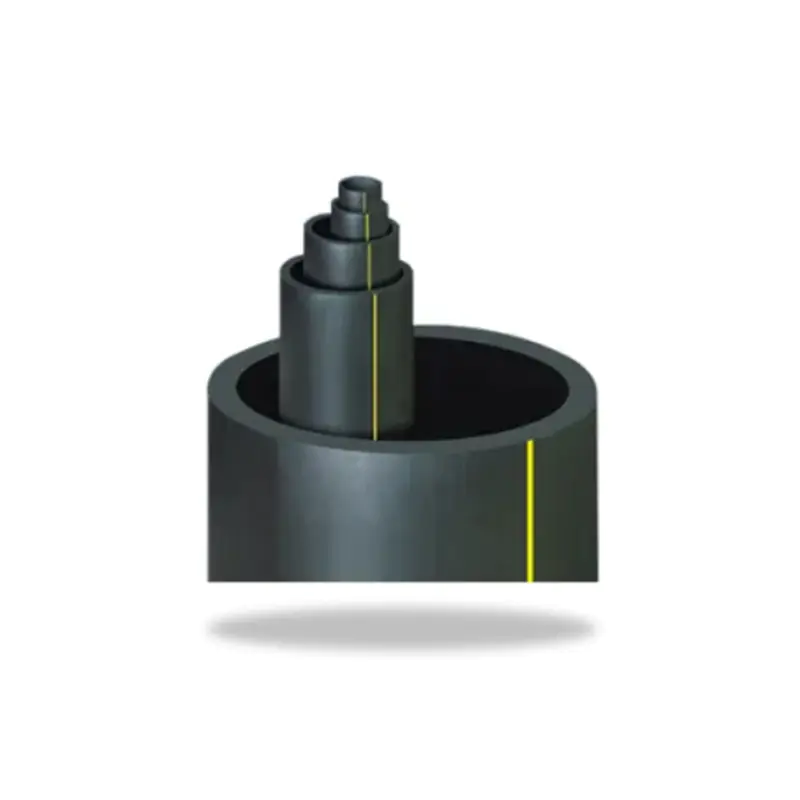Choosing the right HDPE Pipe For Gas to ensure the long-term stability and durability of the gas pipeline involves multiple factors, including pipe performance, material selection, installation technology, etc. Here are some key considerations:
Choosing HDPE materials that meet gas industry standards is the basis for ensuring pipeline stability and durability. Common HDPE pipe materials include PE80, PE100, etc., among which PE100 has higher pressure resistance and durability and is suitable for high-pressure gas pipelines.
PE80: Suitable for low-pressure and medium-pressure gas pipelines.
PE100: Suitable for high-pressure gas pipelines, with stronger pressure resistance, impact resistance and longer service life.
HDPE materials should be UV-resistant, especially when the pipeline is exposed to sunlight. HDPE pipes with anti-UV additives can effectively delay aging and embrittlement caused by UV exposure.
HDPE pipes have good corrosion resistance to most chemicals. When used in soil or water, they can resist the erosion of substances such as acids, alkalis, and salts, ensuring the long-term stability of the pipeline.
HDPE pipes should maintain stable performance under different climatic conditions. For example, it is not easy to become brittle at low temperatures and can maintain good shape and function at high temperatures.
The pressure level of the gas pipeline has an important impact on the wall thickness of the pipeline. Select the appropriate pipeline wall thickness according to the pressure requirements of the use environment to ensure that the pipeline does not break or leak during long-term use. Common standard pressure levels include SDR11 (for pipelines with higher pressure) and SDR17 (for pipelines with general pressure).
The lower the SDR value, the thicker the pipeline wall thickness and the stronger the pressure bearing capacity.
The pipe diameter should be selected according to the gas flow demand and the maximum pressure bearing capacity of the pipeline. A larger pipe diameter can reduce the friction resistance of the pipeline and improve the gas transmission efficiency.
Hot melt connection technology is the most commonly used HDPE pipe connection method. By heating the pipe end to soften and combine it, the strength of the connection is equivalent to the pipe itself. Selecting the appropriate hot melt technology can ensure the sealing and firmness of the connection, thereby preventing leakage problems.
It is suitable for HDPE pipes with larger pipe diameters. By heating the connection end and pressurizing it to form a weld, the connection is ensured to be firm. Applicable to high-pressure gas pipelines.

For scenarios that require flexible disassembly and reconnection, mechanical connections (such as plug-in connections) can be selected. This method is simple and can avoid overheating affecting pipeline performance.
The construction of HDPE pipes needs to be carried out in accordance with standard specifications, especially when hot-melt connections, to ensure the control of welding temperature and time to avoid loose connections.
For the laying of underground gas pipelines, the correct slope design can ensure smooth drainage of the pipeline and avoid water accumulation that causes pipeline pressure or corrosion.
When installing the pipeline, protective measures need to be taken to avoid external physical impact or chemical corrosion, especially in cross-construction or complex geological environments.
The operating temperature range of HDPE pipes is usually between -40℃ and 60℃, and HDPE pipes made of special materials may have a wider temperature adaptability. For cold areas or high temperature environments, choose suitable pipes to ensure that they will not crack or soften at extreme temperatures.
In low temperature environments, the toughness of HDPE may decrease. Therefore, for gas pipelines in cold areas, HDPE materials with better low-temperature performance must be selected, and the wall thickness of the pipeline must be increased.
After the pipeline is installed, regular inspection and maintenance are essential. Leakage in the pipeline can be detected by external monitoring equipment (such as pressure sensors).
For gas pipelines, ensuring that there are no leaks in the pipeline is the most important safety measure. The integrity of the pipeline can be ensured through regular pressure testing and gas detection.
Considering that the pipeline may be subjected to mechanical shock or friction, choose HDPE materials with strong wear resistance, especially in areas that are prone to wear during construction or use.
Choose HDPE pipes certified in accordance with international standards (such as ISO, ASTM, EN, etc.), which ensure the quality and reliability of the pipeline. In addition, it must comply with local laws and regulations on the installation and use of gas pipelines.
The selection of suitable HDPE pipes should not only consider the strength, aging resistance and corrosion resistance of the material, but also need to be combined with the pressure, temperature requirements and installation environment of gas transmission for comprehensive evaluation. Appropriate materials, scientific design, professional installation and maintenance measures are the key to ensure the long-term stable operation of gas pipelines.

 简体中文
简体中文 English
English русский
русский Español
Español Français
Français عربى
عربى Português
Português












